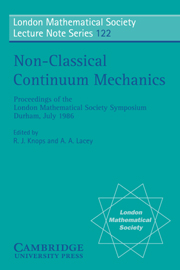 Non-Classical Continuum Mechanics
Non-Classical Continuum Mechanics Book contents
- Frontmatter
- FOREWORD
- Contents
- LIST OF PARTICIPANTS
- PART I PRINCIPAL LECTURES
- PART II SINGLE INVITED LECTURES
- Some Mathematical Problems Arising From the Oil Service Industry
- Randomly Diluted Inhomogeneous Elastic Networks near the Percolation Threshold
- Adaptive Anisotropy: An Example in Living Bone
- Stability of Elastic Crystals
- Optimal Bounds for Conduction in Two-Dimensional, Two-Phase, Anisotropic Media
- Rapid Flows of Granular Materials
- The Constrained Least Gradient Problem
- The Fusion of Physical and Continuum-Mechanical Concepts in the Formulation of Constitutive Relations for Elastic-Plastic Materials
- Singularities in Elliptic Non–Smooth Problems. Applications to Elasticity
- Solitons in Elastic Solids Exhibiting Phase Transitions
- On the Dynamics of Structural Phase Transitions in Shape Memory Alloy
- On the Homogenization of Some Free Boundary Problems
- The Point Interaction Approximation, Viscous Flow Through Porous Media, and Related Topics
Some Mathematical Problems Arising From the Oil Service Industry
Published online by Cambridge University Press: 11 May 2010
- Frontmatter
- FOREWORD
- Contents
- LIST OF PARTICIPANTS
- PART I PRINCIPAL LECTURES
- PART II SINGLE INVITED LECTURES
- Some Mathematical Problems Arising From the Oil Service Industry
- Randomly Diluted Inhomogeneous Elastic Networks near the Percolation Threshold
- Adaptive Anisotropy: An Example in Living Bone
- Stability of Elastic Crystals
- Optimal Bounds for Conduction in Two-Dimensional, Two-Phase, Anisotropic Media
- Rapid Flows of Granular Materials
- The Constrained Least Gradient Problem
- The Fusion of Physical and Continuum-Mechanical Concepts in the Formulation of Constitutive Relations for Elastic-Plastic Materials
- Singularities in Elliptic Non–Smooth Problems. Applications to Elasticity
- Solitons in Elastic Solids Exhibiting Phase Transitions
- On the Dynamics of Structural Phase Transitions in Shape Memory Alloy
- On the Homogenization of Some Free Boundary Problems
- The Point Interaction Approximation, Viscous Flow Through Porous Media, and Related Topics
Summary
INTRODUCTION
An outline is given of the mathematical modelling of some problems which occur in various situations in the oil service industry. In each case the objective is to use a mathematical model as a means of interpreting properties of the formation either during drilling or by well tests after drilling has been completed.
We begin with a brief outline of oil well testing. The main aim of such tests is the recovery of a fluid sample and an estimation of the flow capacity of the formation. We start with a description of a standard procedure for single phase flow (Homer's method (1)) and then discuss the complications introduced when the flow equations are coupled with the temperature. A description is also given of some two phase flow problems.
A second example is that of a mathematical model to be used for interpreting measurements while drilling. This consists of studying the axial vibrations generated by a roller cone bit during the drilling process. Through the model the axial force and displacement histories are calculated at the bit and related to the force and acceleration measured at an MWD (measurements while drilling) site just above the drill bit (possibly as far away as 60 ft.) or at the surface. It is, of course, important to identify the relation between the measured quantities and the values of these quantities at the bit. The objective of this interpretation is to determine formation and bit properties as drilling proceeds so as to facilitate the drilling process.
- Type
- Chapter
- Information
- Non-Classical Continuum MechanicsProceedings of the London Mathematical Society Symposium, Durham, July 1986, pp. 153 - 165Publisher: Cambridge University PressPrint publication year: 1987
